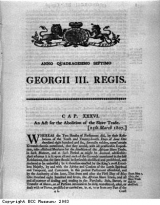The final years of campaigning
Those campaigning against the slave trade kept trying. In 1797, 1798, 1799 and 1802 they proposed changes in the law. These were lost but by only a few votes in the House of Commons. In 1799, there was also a bill, or proposed law, to restrict the slave trade to certain parts of Africa. This bill was passed by the House of Commons but was defeated in the House of Lords. In 1804 and 1805, more bills for the gradual end of the slave trade were introduced. The first in 1804 passed the House of Commons by 69 votes to 36, but did not pass in the House of Lords. The second in 1805 was defeated in the House of Commons.
In 1806, a bill to prevent British slave traders from trading to or on behalf of foreign countries was passed and became law. The reasoning behind this was purely economical. By not allowing British slave traders to supply foreign plantations with slave labour, there would be less competition from produce grown by foreign competitors on their plantations. Few Members of Parliament who supported the slave trade seemed to realise that this new law, the Foreign Act, would destroy between three-quarters and two-thirds of the British slave trade. A large part of the slave trade was dependant on trading to or on behalf of other countries. The new law also made people think that abolition (that is, the end of the slave trade itself) was already in effect. Therefore, there was little opposition to the final push for the end of the slave trade.
In 1807, the Abolition Bill (a proposed new law to end the slave trade) was debated in the Houses of Parliament. It passed both the House of Commons and the House of Lords, and received the Royal Assent (royal agreement) on 25 March. After 1 May 1807, it would be illegal for any ship to leave any port in British colonies on a slaving voyage, and no slaves could be brought to British colonies after 1 March 1808. The penalty if caught slaving after that was a fine of £100 per slave (equivalent today to about £5,000) and the confiscation of the ship. The slaves would be freed and returned to their own country. The Act for the Abolition of the Slave Trade can be seen here. This is the published version of the law that was passed.
The abolition of the slave trade was marked by the issue of several medallions. This commemorative medallion for the abolition of the slave trade shows an African and a European shaking hands. The inscription reads ‘We are all Brethren. Slave Trade Abolished in Great Britain 1807’. On the reverse is the same inscription in Arabic. It had taken 20 years, but the Abolition campaign finally achieved its aim of ending the British trade in enslaved Africans.




